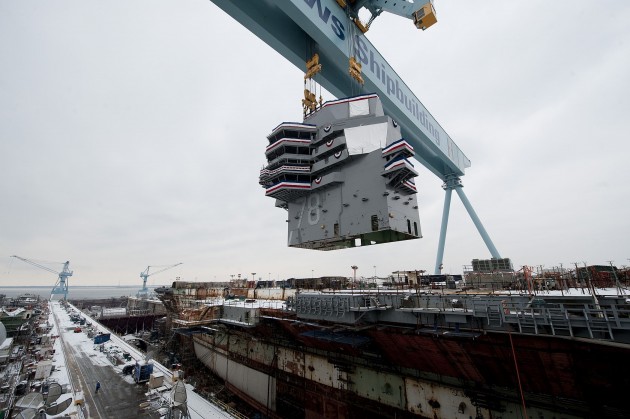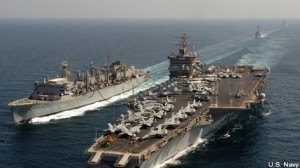Navy Commits To High-Tech Catapults, Arresting Gear For All 3 Ford Carriers
Posted on

The nuclear carrier USS Ford (CVN-78) under construction at Newport News Shipbuilding.
WASHINGTON: Despite congressional doubts, years of delays, and almost $5 billion in overruns, the US Navy has now locked in two controversial high-tech systems for all three of its Ford-class supercarriers. First, a week ago, the Navy announced a review of alternative systems had decided to stick with General Atomics’ Advanced Arresting Gear (AAG) for all three flattops. Today, General Atomics announced it had also won a $533 million sole-source contract to install its Electromagnetic Aircraft Launch System (EMALS) on the third and final ship, the USS Enterprise.

The old USS Enterprise (CVN-65), now decommissioned, in whose honor the third Ford-class ship (CVN-80) is named.
The three carriers won’t be entirely identical. In order to cut costs, for example, the Kennedy (CVN-79) and Enterprise (CVN-80) won’t have the high-powered and high-cost Dual Band Radar used on the Ford (CVN-78). (DBR was originally designed for the ill-fated DDG-1000 Zumwalt destroyers). But the three ships will share the crucial new systems that define the Ford carriers as a class, replacing hard-to-maintain hydraulics and steam with electrical power:
- new nuclear reactors to produce more power;
- a new electrical system (including problematic Main Turbine Generators) to distribute all the energy;
- EMALS to launch planes off the deck without steam catapults; and
- AAG to help planes land without hydraulic arresting gear.
In the future, the Ford‘s enhanced electrical system should also be able to accommodate upgrades like defensive jammers and laser weapons more easily than the older Nimitz class. Here and now, however, because Ford is the first new class of nuclear-powered aircraft carriers since the USS Nimitz joined the fleet in 1975, adding all these revolutionary technologies in a single ship has had rocky results.
![Schematic of CVN-78 Gerald R. Ford, the Navy's new aircraft carrier now under construction. [http://www.navsource.org/archives/02/78.htm]](https://breakingdefense.com/wp-content/uploads/sites/3/2013/05/Navy-aircraft-carrier-CVN-78-Ford-schematic-027806-630x393.jpg)
Schematic of CVN-78 Gerald R. Ford, the Navy’s new aircraft carrier now under construction.
Testing on EMALS is basically done, according to the Navy, but AAG continues to lag behind. Given AAG’s developmental troubles on the Ford, the Navy had considered going back to the old-school Nimitz-class Mark 7, Mod 3 hydraulics for the Kennedy and Enterprise. But doing so would have been a big step backward for the entire design philosophy.
The combination of EMALS to launch and AAG to land is meant not only to be easier to maintain than the old steam and hydraulic systems, but also to be able to keep up a higher pace of operations in combat. Whether that will work in real life is something we won’t know until the Ford begins operational testing at sea.
Subscribe to our newsletter
Promotions, new products and sales. Directly to your inbox.
